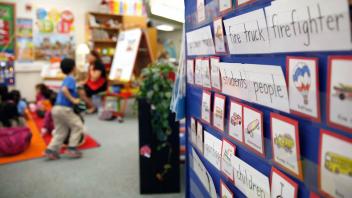Introduction
When attempting to decipher the meaning of a new word, it is often useful to look at what comes before and after that word. The surrounding words can give readers helpful context clues about the meaning and structure of the new word, as well as how it is used.
Using context clues aligns with the following ELA Common Core Standard:
- CCSS.ELA-Literacy.CCRA.L.4 Determine or clarify the meaning of unknown and multiple-meaning words and phrases by using context clues, analyzing meaningful word parts, and consulting general and specialized reference materials, as appropriate.
Helping struggling students use context clues
There are six common types of context clues (see below), and teachers need to provide struggling students and those with learning disabilities with direct instruction in how to use these clues.
Teachers have found it effective to model a self-questioning strategy to identify the different types of context clues. You can ask questions that are designed to focus attention on the unknown word and the possible clues to its meaning, such as: What are the surrounding words? How do these offer me clues? What does this word mean in terms of the context?
It is also helpful to provide students with frequent reminders and examples of the different types of context clues. Using online tools, you can post the list of context clues (and some corresponding examples) on your class wiki, website, or blog. You can also display the list on the bulletin board in your classroom so that students can easily remind themselves about context clues. Students can also keep examples in their reading or writing portfolios.
Embedded supports in digital text
If students are reading digital texts, they can mark the text in a number of different ways to identify context clues. They can highlight, underline, bold, or vary the font (size, style, or color) of unknown words and/or the surrounding context. They can mark the clues that they believe will help them uncover a word’s meaning.
Many supports can also be embedded in the digital text to help students while they are reading. For example, selected words and phrases (the unknown words as well as the surrounding context) can be linked to definitions, synonyms, antonyms, images, and audio explanations. The video, “Embedded Supports to differentiate Instruction for Struggling Students”” provides valuable ideas that can help you use embedded supports to differentiate instruction.
In addition to taking advantage of digital text, students and teachers may find it helpful to use an online dictionary and/or thesaurus. Visual Thesaurus is a dynamic “web” of words that can be expanded and reorganized by students.
In the classroom
Mr. Williams’s Grade 4 class has been studying key humanists from the Middle Ages in social studies. To begin this unit, Mr. Williams wants his students to read a short text about Leonardo da Vinci from the Museum of Science website for reference and as an information-gathering exercise.
He knows that while most of his students will understand the text, his struggling readers will need differentiated support to succeed. The specific objective of the lesson is to have his students review the different types of context clue, and to practice using them to define vocabulary words. This aligns closely with two specific ELA Common Core State Standards:
- CCSS.ELA-Literacy.RI.4.4 Determine the meaning of general academic and domain-specific words or phrases in a text relevant to a Grade 4 topic or subject area.
- CCSS.ELA-Literacy.RF.4.4c Use context to confirm or self-correct word recognition and understanding, rereading as necessary.
His students are able to read the digital text using a variety of devices, including tablets, e-readers, and laptops. He plans to introduce Visual Thesaurus to his students so they can practice using the relationships between words to help them define words that are unfamiliar. Some students will also need to use online dictionaries to confirm that their definitions are correct.
Below is Mr. Williams’s lesson plan. Throughout the lesson (before, during, and after reading), he will engage in formative assessment by observing his students and noting areas of difficulty he can address in future lessons.
Lesson plan
Before Reading
- Review the skill: context clues.
- Explain the purpose of the lesson, building on past lessons using context clues.
- Model how to find context clues.
During Reading
- Display a short passage about da Vinci on the interactive whiteboard.
- Have students read the passage in pairs.
- Invite students to come up to the whiteboard and highlight unfamiliar words and surrounding context clues.
- Have students share their thinking and discuss.
- To confirm their thinking, have students search for words in dictionaries and other resources.
- Repeat the process for one or two more words.
- Have students use context clues to understand new vocabulary and track these words on the class wiki.
After Reading
- Have students share their answers and prompt them to explain their process.
- In pairs, have students discuss at least two ways to figure out the meaning of a new word.
- Create a reference list of strategies.
More teacher resources for context clues
This article draws from the PowerUp WHAT WORKS website, particularly the Context Clues Instructional Strategy Guide . PowerUp is a free, teacher-friendly website that requires no log-in or registration. The Instructional Strategy Guide includes a brief overview of context clues and an accompanying slide show; a list of the relevant ELA Common Core State Standards; evidence-based teaching strategies to differentiate instruction using technology; a case story; short videos; and links to resources that will help you use technology to support instruction in context clues. If you are responsible for professional development, the PD Support Materials provide helpful ideas and materials for using the resources on context clues. Want more information? See www.PowerUpWhatWorks.org .
